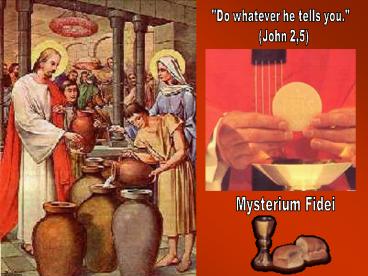Mysterium Fidei - PowerPoint PPT Presentation
Title: Mysterium Fidei
1
"Do whatever he tells you." (John 2,5)
With the same maternal concern which she showed
at the wedding feast of Cana, Mary seems to say
to us Do not waver trust in the words of my
Son. If he was able to change water into wine, he
can also turn bread and wine into his body and
blood, and through this mystery bestow on
believers the living memorial of his pass over,
thus becoming the 'bread of life'.
Mysterium Fidei
2
In a certain sense Mary lived her Eucharistic
faith even before the institution of the
Eucharist, by the very fact that she offered her
virginal womb for the Incarnation of God's Word.
At the Annunciation Mary conceived the Son of God
in the physical reality of his body and blood,
thus anticipating within herself what to some
degree happens sacramentally in every believer
who receives, under the signs of bread and wine,
the Lord's body and blood.
3
There is a profound analogy between the Fiat
which Mary said in reply to the angel, and the
Amen which every believer says when receiving the
body of the Lord. Mary was asked to believe that
the One whom she conceived through the Holy
Spirit was the Son of God (Lk 130-35). In
continuity with the Virgin's faith, in the
Eucharistic mystery we are asked to believe that
the same Jesus Christ, Son of God and Son of
Mary, becomes present in his full humanity and
divinity under the signs of bread and wine.
4
"Blessed is she who believed" (Luke 145)
Mary also anticipated, in the mystery of the
incarnation, the Church's Eucharistic faith.
When, at the Visitation, she bore in her womb the
Word made flesh, she became in some way a
tabernacle the first tabernacle in history
in which the Son of God, still invisible to our
human gaze, allowed himself to be adored by
Elizabeth, radiating his light as it were through
the eyes and the voice of Mary.
5
And is not the enraptured gaze of Mary as she
contemplated the face of the newborn Christ and
cradled him in her arms
that unparalleled model of love which should
inspire us every time we receive Eucharistic
communion?
6
When she brought the child Jesus to the Temple in
Jerusalem to present him to the Lord (Lk 222),
she heard the aged Simeon announce that the child
would be a sign of contradiction and that a
sword would also pierce her own heart (cf. Lk
234-35). The tragedy of her Son's crucifixion
was thus foretold, and in some sense Mary's
Stabat Mater at the foot of the Cross was
foreshadowed.
In her daily preparation for Calvary, Mary
experienced a kind of anticipated Eucharist
one might say a spiritual communion of desire
and of oblation, which would culminate in her
union with her Son in his passion, and then find
expression after Easter by her partaking in the
Eucharist which the Apostles celebrated as the
memorial of that passion.
7
What must Mary have felt as she heard from the
mouth of Peter, John, James and the other
Apostles the words spoken at the Last Supper
This is my body which is given for you (Lk
2219)? The body given up for us and made
present under sacramental signs was the same body
which she had conceived in her womb! For Mary,
receiving the Eucharist must have somehow meant
welcoming once more into her womb that heart
which had beat in unison with hers and reliving
what she had experienced at the foot of the Cross.
8
Created by Lilly Medina lilly_marie_at_bellsouth.net
Do this in remembrance of me (Luke 2219)
In the memorial of Calvary all that Christ
accomplished by his passion and his death is
present. Consequently all that Christ did with
regard to his Mother for our sake is also
present. To her he gave the beloved disciple and,
in him, each of us Behold, your Son!. To each
of us he also says
"Behold your mother" (Jhon 19 26-27)





![[PDF] Mysterium Coniunctionis (Collected Works of C.G. Jung Vol.14) Kindle PowerPoint PPT Presentation](https://s3.amazonaws.com/images.powershow.com/10082361.th0.jpg?_=20240720085)

























